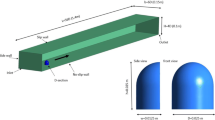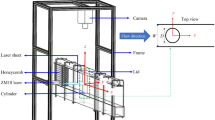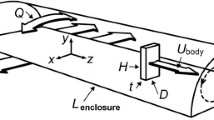Abstract
A study on the relation between the wake inlet conditions and the wake characteristics of a bluff body by means of Particle Image Velocimetry is presented. The wake inlet condition, being a laminar boundary layer at the trailing edge of the body, are varied by means of wall-suction. Measurements are carried out at \(Re_{h} = 6.7\times 10^{3}\) based on the body thickness h. The induced radius of curvature of the streamlines is shown to be a promising parameter in explaining the increase in base drag and decrease in vortex shedding frequency associated with a thinner boundary layer.
Access provided by Autonomous University of Puebla. Download conference paper PDF
Similar content being viewed by others
Keywords
- Particle Image Velocimetry
- Streamwise Velocity
- Bluff Body
- Thin Boundary Layer
- Particle Image Velocimetry Algorithm
These keywords were added by machine and not by the authors. This process is experimental and the keywords may be updated as the learning algorithm improves.
1 Introduction
Vortex shedding is the result of an absolute instability, which is manifested with vortices being shed at a fixed frequency from alternating sides of a bluff body. This phenomena causes an increase in the base drag [1]. Methods to reduce the base drag are either based on manipulation of the vortex interaction or on modification of the boundary layers separating from the trailing edges of the body [2, 3]. Previous studies indicate that an increase of the boundary layer thickness leads to a decrease of the base drag and a reduction of the vortex shedding frequency [4–6]. It has been suggested that the change in curvature of streamlines may be the cause of this altered base drag [7]. In other to gain more fundamental knowledge of the flow around bluff bodies it is therefore of paramount importance to study the boundary layer separating from the trailing edge in combination with the formation recirculation region where the interaction between shear layers takes place [8].
A novel experimental setup that enables the variation of the inlet boundary condition prior to separation of a bluff body has recently been reported [6]. The novelty lies in the way in which the inlet conditions are being modified. The body, that will be described more extensive in Sect. 2, has a perforated top and bottom surface, which allows for boundary layer modifications by means of suction and/or blowing. In the first study [6] an elaborate description of laminar and turbulent boundary layers subject to suction is given. Based on hot-wire anemometry and differential pressure measurements the wake inlet conditions were related to the wake characteristics.
In the present study, the measurements described in [6] are complemented with Particle Image Velocimetry (PIV) measurements to include the near wake topology as well as the region prior to separation. A first result in the study of the wake characteristics including the curvature of streamlines will be shown.
2 Experimental Setup
The measurements have been carried out in the closed circuit Boundary Layer (BL) wind tunnel located in the Odqvist Laboratory at the Royal Institute of Technology (KTH). The background turbulence intensities are 0.04 % and 0.06 % in the streamwise and cross-flow directions, respectively, at a free-stream velocity of \(25~\text {m}/\text {s}\). The BL-tunnel has a \(4~\text {m}\) long interchangeable test section with a cross-sectional area of \(0.5~\text {m}\) in width and \(0.75~\text {m}\) in height.
Within the test section a \(2~\text {m}\) long rectangular body is mounted horizontally, see Fig. 1. The body spans the entire test section width and is \(h~=~4.0\,\text {cm}\) thick, which corresponds to a blockage equal to \(5.3\,\%\). A smooth, elliptically shaped, leading edge with a length of \(30\,\text {cm}\) is added to prevent leading edge separation. The trailing edge is blunt, hence, the point of separation is fixed at the trailing edge corner.
The titanium top and bottom surfaces of the body are perforated to allow for suction and blowing. A porosity of \(0.5\,\%\) is realised by \(60~\upmu \text {m}\) laser drilled holes which are uniformly distributed across the total surface. A measure of the wall-normal velocity is obtained by relating the pressure drop over the perforate plate to the velocity of air through the perforations, on the basis of a relation given by [9].
The Particle Image Velocimetry (PIV) measurements were carried out with a Dantec Dynamics PIV system, composed of a Litron DualPower 50–200 laser (\(50~\text {mJ}\), \(200~\text {Hz}\)) and, in the present configuration, two SpeedSense M120 cameras (12 bits) which have a sensor resolution of \(1920 \times 1200\) pixels. The cameras, mounted in a planar configuration as shown in Fig. 1, were equipped with \(50~\text {mm}\) objectives to obtain field of views of \(FOV~=~140\times 88~\text {mm}^{2}\). A number of 1825 images were recorded at a repetition rate of \(100~\text {Hz}\), which is sufficient to resolve the vortex shedding frequency. The pulse separation time of \(\varDelta t~=~700~\upmu \text {s}\) was based on an average particle displacement of \(25\,\%\) within the initial interrogation area. This initial interrogation area of \(128\times 128\)-px is reduced in a multi-pass PIV algorithm to a final interrogation resolution of \(16\times 16\)-px, corresponding to a resolution of \(1.2~\text {mm}\). Due to the thin boundary layer in case of suction and strong reflection at the titanium surface the boundary layer could not be fully resolved, but information on the streamline curvature prior to separation could be calculated.
Two single hot-wire probes, operated in combination with a Dantec Dynamics StreamLine 90N10 system, are used. One to measure the velocity profiles and another one to obtain the vortex shedding frequency, which is mounted downstream of the trailing edge on the border of the wake. The reference free-stream velocity \(U_{\infty }\) was measured with a Prandtl tube mounted through the ceiling of the test section. The differential pressure was recorded using a Furness FCO510 (0–200/2000 Pa, 0.25 % FSD) pressure transducer. The same pressure transducer was used to measure the pressure across the perforated surfaces and the base pressure at the center of the base. The static pressure of the Prandtl tube was used as reference in both cases.
3 Results
All measurements are carried out at a free-stream velocity of \(U_{\infty }~=~2.5~\text {m}/\text {s}\), which corresponds to Reynolds numbers of \(Re_{h} = 6.7\times 10^{3}\) and \(Re_{L} = 3.8\times 10^{5}\) based on the base height h and the length of the body L, respectively. Hence, the boundary layer is laminar at the point of separation.
For a laminar boundary layer subject to wall suction, the streamwise velocity distribution \(U/U_{\infty }\) will asymptote to an exponential form:
with \(V_{0} (<0)\) being the wall-normal velocity and \(\nu \) the kinematic viscosity. The displacement thickness \(\delta _{1}\) and momentum thickness \(\delta _{2}\) for the ASBL are given by:
and hence, independent of the free-stream velocity.
For a flat surface of limited extent, like the body in the present study, the ASBL is only obtained in case a sufficiently large wall-normal velocity relative to the free-stream velocity is applied. Here we define the suction coefficient \(\varGamma \):
as a measure of the amount of suction applied. In Fig. 2a boundary layer profiles at a distance of 1h upstream of the trailing edge for several suction coefficients are shown, where a larger suction coefficient corresponds to a lighter shade of gray, black being the neutral suction case. An increase in suction coefficient leads to a thinner boundary layer with a larger velocity gradient at the wall. From Fig. 2b, in which the normalized displacement thickness \(\delta _{1}\) and \(\delta _{2}\) are presented as function of the suction coefficient, it can be concluded that the ASBL in this case is reached for \(\varGamma \approx 6\). For more information on laminar and turbulent boundary layers subject to suction the interested reader is referred to [6].
a The time averaged streamwise velocity component U, with the selected streamline to extract the radius of curvature R marked in blue and the confluence point marked with a white ‘\(\times \)’, b the position of the confluence point \(x_{C}\) as function of the suction coefficient \(\varGamma \), c the maximum radius of curvature R/h along the selected streamline as function of \(x_{C}\), d \(+\) e the Strouhal number St and base pressure \(-C_{p,b}\) as function of R/h, respectively
In Fig. 3a the time averaged formation region for the neutral suction case is visualized by means of streamlines and constant streamwise velocity contours. The formation region is characterized here by two parameters. 1: The confluence point \(x_{C}\), which is here defined as the saddle point where both the wall-normal as well as the streamwise velocity component are equal to zero. 2: The induced curvature of the streamlines. A streamline at a distance \(y_{s}\) from the body surface at the trailing edge is selected, where \(y_{s} = \eta \delta _{99}\) is a position relative to the boundary layer thickness \(\delta _{99}\). Here \(\eta = 0.5\) was chosen. The radius of curvature along this streamline is subsequently found by applying the standard mathematical equation:
The characteristic curvature of the streamline was then decided to be the maximum radius of curvature found along the streamline.
From Fig. 3b it can be derived that an increase in suction leads to a shorter formation region. For \(\varGamma >6\), where the ASBL is reached, the recirculation seems to approach a minimum. This can be explained by the fact that the boundary layer thickness becomes negligible compared to the body thickness to play a significant role in the wake formation. At the same time, in the case of the ASBL the boundary layer shape is constant.
In Fig. 3c the two parameters of the formation region are compared. It is concluded that the a shorter recirculation region corresponds to a proportional change in the radius of curvature of the streamline. This is an indication that an appropriate method to determine a characteristic radius of curvature was chosen.
From Fig. 3d, e it can be observed that both the Strouhal number based on the shedding frequency \(St = fh/U_{\infty }\), and the base pressure coefficient correlate fairly well with radius of curvature, at least for the \(Re_{h}\) studied here. However, we should keep in mind that we have compared the time averaged base pressure coefficient and the time averaged formation region, a flow condition the fluid does never actually experience. Future research will therefore include the phase averaged data of the formation region, as well as a range of Reynolds numbers.
4 Conclusion
A first analysis of velocity field data obtained in the area prior to separation and in the formation region of a bluff body has been shown to be a promising database to investigate the relation between the wake characteristics and wake inlet conditions.
References
M.M. Zdravkovich, Flow around circular cylinders, in Fundamentals, vol. 1 (1997)
V. Durgesh, J.W. Naughton, S.A. Whitmore, Experimental investigation of base-drag reduction via boundary-layer modification. AIAA J. 1–10 (2013)
H. Choi, W.-P. Jeon, J. Kim, Control of flow over a bluff body. Annu. Rev. Fluid Mech. 40, 113–139 (2008)
A. Rowe, A.L.A. Fry, F. Motallebi, Influence of boundary-layer thickness on base pressure and vortex shedding frequency. AIAA J. 39(4), 754–756 (2001)
A. Mariotti, G. Buresti, Experimental investigation on the influence of boundary layer thickness on the base pressure and near-wake flow features of an axisymmetric blunt-based body. Exp. Fluids 54(11), 1–16 (2013)
R. Trip, J.H.M. Fransson, Boundary layer modification by means of wall suction and the effect on the wake behind a rectangular forebody. Phys. Fluids 26(12), 125105 (2014)
G. Buresti, Elements of Fluid Dynamics, vol. 3 (Imperial College Press, 2012)
Z.J. Taylor, E. Palombi, R. Gurka, G.A. Kopp, Features of the turbulent flow around symmetric elongated bluff bodies. J. Fluids Struct. 27(2), 250–265 (2011)
S. Goldstein, Modern Developments in Fluid Dynamics, vol. 1 (1938)
Author information
Authors and Affiliations
Corresponding author
Editor information
Editors and Affiliations
Rights and permissions
Copyright information
© 2016 Springer International Publishing Switzerland
About this paper
Cite this paper
Trip, R., Fransson, J.H.M. (2016). An Experimental Study on the Relation Between the Wake Inlet Conditions and the Near Wake Topology. In: Segalini, A. (eds) Proceedings of the 5th International Conference on Jets, Wakes and Separated Flows (ICJWSF2015). Springer Proceedings in Physics, vol 185. Springer, Cham. https://doi.org/10.1007/978-3-319-30602-5_17
Download citation
DOI: https://doi.org/10.1007/978-3-319-30602-5_17
Published:
Publisher Name: Springer, Cham
Print ISBN: 978-3-319-30600-1
Online ISBN: 978-3-319-30602-5
eBook Packages: Physics and AstronomyPhysics and Astronomy (R0)







